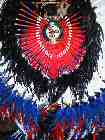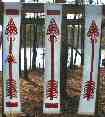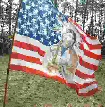
by Devang Desai
Order of the
Arrow National Bulletin, vol 51 Issue 1 & Issue
2
Copyright © 1999 Boy Scouts of America
Since its beginning in 1915, the Order of the Arrow has recognized its members with a visible sign of membership-- the Order of the Arrow sash. Although times have changed, use of the OA sash has remained fairly constant.
According to the Order's fifth Vigil Honor member, Harry A. Yoder, in the early days of the Order the members wore black sashes with a white stripe running lengthwise instead of the white sash with the red arrow. The original sash was black because it offered a great contrast to the white bar and it blended well with the black ceremonial robes. (Yoder also served as a guide and guardian in the first OA ceremony, on July 16, 1915.)

original black "band" with white
stripe
[This is contrary to what BSA National promoted for the
75th Anniversary, when awards and other memorabilia depicted the first
black sashes had white arrows. In 1992, when I was serving in
Woodland District, Philadelphia Council, I was told by several Unami Lodge
officers and members that these first sashes had white stripes, not
arrows. That same year, Unami issued several flaps (s14 and s15) that
depicted this. This is also supported by the 60th Anniversary First Degree
Ritual reenactment that Dr. Goodman attended and posed with.
See
photo.]
Sashes from this time period are rare to find and, though
rumored to exist in private collections, no black sashes from this era
have surfaced publicly. [Bill Topkis, in his recent article published in
The Blue Book, 4th ed., questions their very existence. He also
recounts that in 1989 National was in fact unable to locate a "black sash"
for the 75th Anniversary.]

black sash with white
arrow
Unlike our present three levels of membership, the Order
of the Arrow originally had only two levels [called degrees]. The [First
Degree] combined aspects of the present-day Ordeal and Brotherhood
memberships, while the [Second Degree] was an early adaptation of the
Vigil Honor.
In 1915, the OA did not exist as a national organization,
nor did it have lodges. The Order was referred to as simply as ["WWW"].
During the early 1920s, the brothers gathered to establish and formalize
the organization. They created the Unami Constitution, which laid
out the Order's vision. It was at this time that the symbol of the Order
was adopted-- a white sash with a red arrow.

Ordeal sash (right
shoulder) or Brotherhood sash (left shoulder)
1922 -
48
In this era, Arrowmen who were Ordeal members wore a
white sash with a red arrow over their right shoulder. Brotherhood members
wore a white sash with a red arrow over their left shoulder. A brother in
the Vigil Honor wore three sashes-- one over the right shoulder,
one over the left shoulder and one around the girth of his waist. There
were no sashes for the Vigil Honor produced until 1933.
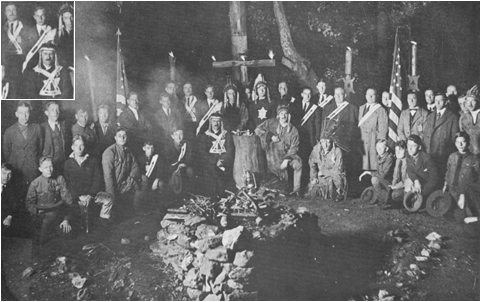
See
larger image
First organizational meeting of the Grand Lodge,
Camp Biddle, 1921
notice sashes worn over the left shoulder
(Brotherhood), and the three sashes worn at once
(Vigil)
A Pictorial History of
Unami Lodge One and Information for its Members, 5th ed., p.
8
Jeffrey A. Aster, editor, Copyright © 1990 Philadelphia
Council, BSA
Each OA lodge was responsible for producing its own
sashes. The BSA Supply Division did not produce OA sashes. Lodges would
generally make sashes out of felt with canvas or felt arrows. In 1927, the
Supply Division began producing Ordeal sashes for the growing OA
organization. Sash collectors have identified sashes from the 1920s by the
thickness of the arrow's shaft.
In 1933, the OA produced the first Vigil Honor sash. It
was a plain white felt sash without an arrow. The felt sash had an
oversized felt triangle with three felt arrows [that pointed in a
clockwise direction] inside the triangle.

First Vigil Honor
sash
1933
A year later, an arrow was added to the Vigil sash. The
sash was also made of a cloth backing on the felt, which in turn would
help preserve the felt. The next major change on the Vigil sash was the
use of embroidered [counterclockwise] arrows in the oversized triangle
instead of felt arrows. In addition, the backing was removed from the felt
sash.

Vigil Honor sash
1934
- 48
Around 1946, OA founder Dr. E. Urner Goodman created a
Vigil Honor sash for members of the national OA committee as a way of
thanking them for their service. This limited edition Vigil Honor sash had
a white arrow on a red sash with white arrows inside the oversized felt
Vigil triangle.

Red Vigil Honor sash for
members of National Committee
circa
1946
In 1948, a major development for the OA sash occurred.
This is the period that collectors call "flock on felt." The sash itself
was made of felt, but the arrow used was flocked-- in other words,
spray-painted. The Vigil Honor sash was also flocked, and had an arrow
with an oversized felt triangle, but the arrows within the oversized
triangle were silk-screened.

Vigil Honor
flocked-on-felt sash
1948 -
1950
During late 1951, [for the first time] Brotherhood bars
were flocked on the OA sash. Also during this period the oversized felt
triangle on the Vigil Honor sash was reduced and flocked onto the sash.
The flocking of OA sashes ended in 1954 with the introduction of twill
cloth with embroidered arrows.

Brotherhood
flocked-on-felt sash
1951 - 54

Vigil Honor
flocked-on-felt sash
1951 -
54
As the use of twill cloth became dominant, two major
stitches were used to bind the edges of the cloth sashes. The first was
the railroad track stitch, or the double-stitched edge (used mostly from
1955-59), and the second was the rolled-edge stitch (used mostly from
1960-80). In 1980, the stitching on the twill cloth sashes changed from
rolled-edge to chain-stitched edges. The last of the chain-stitched sashes
were made in 1988, at which point single stitching was used.

Brotherhood twill
sash
1954 - 88

Vigil Honor twill
sash
1954 - 88
In 1988, the [BSA National Supply Division] created twill
cloth sashes with iron-on or appliqued arrows. These sashes were produced
for only two years because the arrows were literally peeling off. [These
sashes were known as "lick 'em and stick 'ems," as the iron-on's were
notorious for coming right off in the washing machine! The Vigil sashes
were also given triangles with clockwise arrows.] The OA then
returned to embroidered arrows (including the insignia for Brotherhood
and the Vigil Honor) on twill cloth using a single-stitched edge.

1988 - 90ir
on-on Vigil Honor sash
w/ clockwise arrows

(current)
counterclockwise
arrows
|

clockwise
arrows
1988 - 90
|
To commemorate the 75th anniversary of the Order of the
Arrow, the national organization reproduced a collector's black sash with
white embroidered arrows as a souvenir for the 1990 National Order of the
Arrow Conference. To ensure that members did not wear this sash, it was
produced without a snap-clasp and was made shorter than the average
sash.

75th
Anniversary Commemorative black
sash
1990
In 1990, the national chairman of the OA committee, Dr.
Carl Marchetti, produced a [red] sash for members of the national OA
committee that was a replica of Goodman's gift to the 1946 OA committee.
The sash was to be worn by committee members, the national chief, and
national vice chief only during Founders' Day at the 1990 National
Conference. [White embroidered 75th Anniversary at top.]


75th Anniversary National Committee Red
Sash
(50 made)
Dr. Marchetti stepped down as chairman of the national OA
committee on June 15, 1993. To celebrate his tenure as chairman, he
produced a limited number of black Ordeal sashes with a white embroidered
arrow for the national chief, national vice chief, and members of the
national OA committee. Each sash [had a white cloth inner band and] was
[signed,] numbered and contained a special personalized message from Dr.
Marchetti.

1993 National Committee
Black Sash
(75 made)
Through the years, the use of the OA sash has remained constant even though there have been occasional changes in the stitching and positioning of arrows inside the Vigil triangle. During the 83 years of the organization's existence, the sash continues to remain the visible symbol of service as was intended by the Order of the Arrow cofounders.
Information for this article was obtained from Order of the Arrow historians Kenneth Davis, Terry Grove, and Harris Tanner.
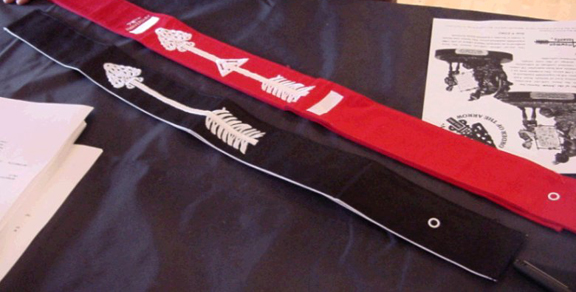
White on Red, White on
Black
on display for the 2000 NOAC, from the Official National OA Site
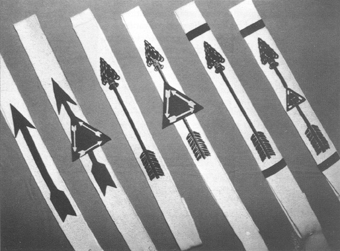
Order of the Arrow sashes, 1922-55:
- Ordeal and Brotherhood sash from 1922-48
- Vigil sash from 1934-48
- Ordeal and Brotherhood sash from 1948-50
- Vigil sash 1948-50
- Brotherhood sash 1951-55
- Vigil sash 1951-55
The Brotherhood of Cheerful Service: A History of the Order of the Arrow, 1st ed., p. 57
Kenneth P. Davis, editor
Copyright © 1990 Boy Scouts of America
Sashes 1 and 2 have red wool felt arrows sewn on a white felt sash. Sashes 3 through 6 have red arrows flocked on white felt. After 1955, sashes were made with red full-embroidered arrows on white cotton twill. In 1988, the National Supply Division experimented with iron-on arrows that were discontinued shortly thereafter.

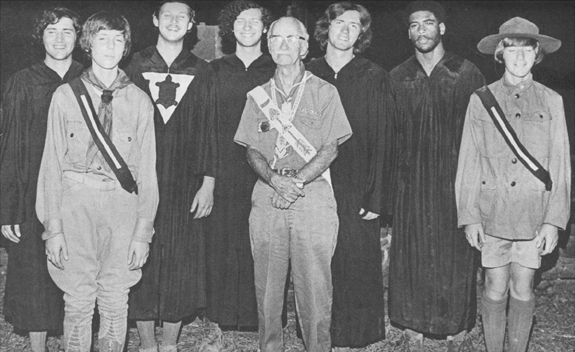
Reenactment of the original First Degree Ritual with
founder Dr. Goodman.
60th Anniversary Celebration, Treasure Island SR,
July 19, 1975
A Pictorial History of Unami Lodge
One and Information for its Members, 5th ed., Jeffrey A. Aster,
editor, p. 25
Copyright © 1990, Philadelphia Council, BSA
